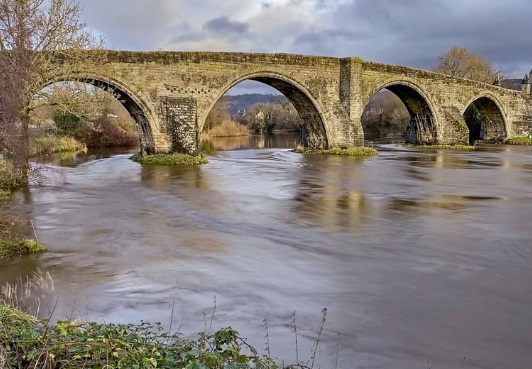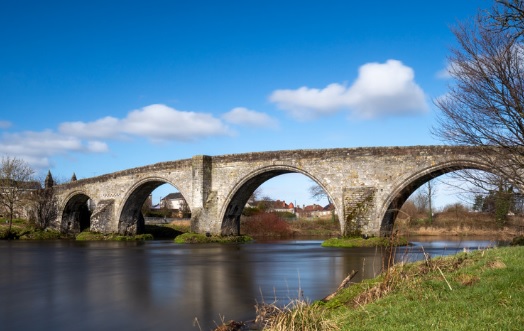Stirling Bridge
Spanning the River Forth near the city of Stirling, Stirling Bridge is far more than a crossing — it is a symbol of Scottish resilience, courage, and national identity. Immortalised in history as the site of the Battle of Stirling Bridge (1297), where William Wallace and Andrew Moray achieved a stunning victory over English forces, the bridge and its surroundings remain one of the most significant historic locations in Scotland. Today, it stands as a poignant reminder of Scotland’s struggle for independence and the enduring spirit of its people.
A Bridge at the Heart of Scotland
Stirling’s position has always been one of immense strategic importance. The River Forth winds its way across central Scotland, creating a natural barrier between the Highlands and Lowlands. For centuries, Stirling was the lowest fixed crossing point on the river, making it a vital link for trade, travel, and military movement. Whoever controlled Stirling Bridge effectively controlled the route north and south through the country.
By the late 13th century, as Scotland became embroiled in the Wars of Independence, this crossing gained enormous military significance. The stone and timber bridge that stood here in 1297 was narrow — only wide enough for two horsemen to pass side by side — and it would soon become the stage for one of the most famous battles in Scottish history.
The Battle of Stirling Bridge (11 September 1297)
Following the death of Alexander III and the political instability that ensued, Scotland found itself under increasing English control. In 1296, King Edward I of England invaded and claimed overlordship of Scotland, sparking widespread rebellion. Among the resistance leaders were William Wallace, a knight of humble origins, and Andrew Moray, a nobleman from the north.
By the summer of 1297, Wallace and Moray had already achieved several local victories and gathered a substantial force of Scottish soldiers. The English army, led by John de Warenne, Earl of Surrey, and Hugh de Cressingham, the English treasurer in Scotland, marched north to crush the uprising.
When the two armies met at Stirling, the English force outnumbered the Scots — estimates suggest over 8,000 English soldiers, including 3,000 heavy cavalry, against roughly 2,000–3,000 Scots. However, the Scots held the advantage of terrain and strategy.
Wallace and Moray positioned their troops on high ground north of the River Forth, near the Abbey Craig — the hill that now hosts the Wallace Monument. The English army camped on the opposite side of the river, intending to cross the narrow bridge and engage the Scots.
What followed was a masterstroke of tactical genius. As the English began crossing the bridge in small numbers, the Scots waited patiently. When enough English soldiers had crossed to form a manageable target — but before they could form an effective battle line — Wallace and Moray launched their attack.
Charging down from the high ground, the Scots cut off the English advance by seizing control of the bridge, trapping part of the army on the northern side. With no room to manoeuvre and no reinforcements able to cross, the English troops were slaughtered or forced into the river, where many drowned.
Among the dead was Hugh de Cressingham, whose death became infamous in Scottish folklore. According to legend, parts of his skin were flayed and used to make sword belts — a gruesome but symbolic act of retribution. The Battle of Stirling Bridge ended with a decisive Scottish victory and sent shockwaves through England. It was a defining moment that proved Scotland’s resistance was far from crushed.

Aftermath and Historical Impact
The victory at Stirling Bridge transformed William Wallace into a national hero and strengthened the cause of Scottish independence. Wallace and Moray were soon declared Guardians of Scotland, ruling in the name of the exiled King John Balliol. Unfortunately, Andrew Moray was mortally wounded during the battle and died shortly afterward, but his leadership and tactical insight were instrumental in the triumph.
The battle did not end the conflict — Edward I returned with overwhelming force the following year and defeated Wallace at Falkirk (1298) — but Stirling Bridge had demonstrated that strategy, terrain, and determination could overcome superior numbers. It became a symbol of defiance and unity for generations to come.
The Bridge Through the Ages
The original wooden bridge from 1297 no longer exists, but archaeological research has identified its approximate location — a short distance upstream from the current Old Stirling Bridge. The existing stone structure, built in the late 15th or early 16th century, is itself a remarkable piece of medieval engineering. Constructed with two graceful arches of stone, it served as Stirling’s main crossing for centuries and remains an evocative landmark.
In 1745, during the Jacobite Rising, part of the bridge was destroyed by government troops to slow the advance of Bonnie Prince Charlie’s forces. The damaged section was later repaired, and today the bridge is preserved as a scheduled monument, pedestrianised and open for visitors to walk across — tracing the steps of history.
Legacy and Commemoration
The legacy of Stirling Bridge endures not only in stone but in Scottish identity itself. The site continues to attract historians, tourists, and patriots from across the world. The nearby National Wallace Monument, erected in 1869, stands as a towering tribute to Scotland’s national hero and offers sweeping views of the battlefield.
Annual reenactments and educational programs ensure that the story of Wallace, Moray, and the Battle of Stirling Bridge remains alive for future generations. The area around the bridge is part of a heritage landscape that also includes Stirling Castle and Bannockburn, creating a powerful trilogy of sites that together tell the story of Scotland’s fight for freedom.
Stirling Bridge is more than a crossing over the River Forth — it is a symbol of resistance, ingenuity, and national pride. The events of 11 September 1297 forever changed the course of Scottish history, proving that courage and clever strategy could triumph over brute force. Standing on the Old Stirling Bridge today, one can still imagine the roar of battle and the echo of freedom that began there — a legacy that continues to define the spirit of Scotland.
